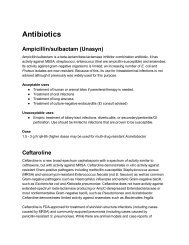Skin and Soft Tissue Infections - UCLA
Skin and Soft Tissue Infections - UCLA
Skin and Soft Tissue Infections - UCLA
You also want an ePaper? Increase the reach of your titles
YUMPU automatically turns print PDFs into web optimized ePapers that Google loves.
●<br />
PCN allergy: Vancomycin (see dosing section) PLUS Ciprofloxacin 400 mg IV q12h<br />
PLUS Clindamycin 600-900 mg IV q8h<br />
If confirmed beta-hemolytic streptococci:<br />
● Penicillin G 24 Million Units as continuous infusion PLUS Clindamycin 600-900 mg IV<br />
q8h<br />
OR<br />
● PCN allergy: Vancomycin (see dosing section) PLUS Clindamycin 600-900 mg IV q8h<br />
TREATMENT NOTES<br />
Conventional nomenclature <strong>and</strong> microbiology<br />
Pyomyositis (purulent infection of skeletal muscle, usually with abscess formation)<br />
● S. aureus most commonly<br />
● Clostridial myonecrosis - Clostridia spp (esp C. perfringens)<br />
● Group A streptococcal myonecrosis<br />
Fasciitis (infection of the subcutaneous tissue that results in progressive destruction of fascia<br />
<strong>and</strong> fat, but may spare the skin)<br />
● Type 1 - Polymicrobial infections with anaerobes, streptococci <strong>and</strong> gram-negative rods<br />
(Fournier’s gangrene is a type 1 necrotizing fasciitis of the perineum)<br />
● Type 2 - Group A streptococci<br />
● Cases of fasciitis caused by community-acquired MRSA have been reported<br />
● Case-cohort studies <strong>and</strong> case reports have suggested some benefit to treatment with<br />
intraveous immunoglobulin (IVIG) in specific circumstances (e.g., streptococcal toxic<br />
shock). However, due to the lack of r<strong>and</strong>omized controlled trials, IVIG should probably<br />
be reserved for select patients. Infectious Diseases consult is advised.<br />
Diagnosis<br />
● Can be difficult - gas production is not universal <strong>and</strong> is generally absent in streptococcal<br />
disease.<br />
● Can follow minor or major trauma, especially when risk factors are present.<br />
● Maintain high index of suspicion when:<br />
○ Patients are very ill from cellulitis (hypotension, toxic)<br />
○ Pain out of proportion to exam findings.<br />
○ Anesthesia over affected area<br />
○ Risk factors such as diabetes, recent surgery, or obesity<br />
○ Findings such as skin necrosis or bullae<br />
○ Putrid discharge with thin, “dishwater” pus<br />
● CT scan can help with diagnosis but if suspicion is moderate to high, surgical exploration<br />
is the preferred diagnostic test. DO NOT delay surgical intervention to obtain CT.<br />
● Initial histopathologic findings may be of prognostic importance. A poor neutrophil<br />
response with numerous organisms seen on routine stains implies a poor prognosis.





